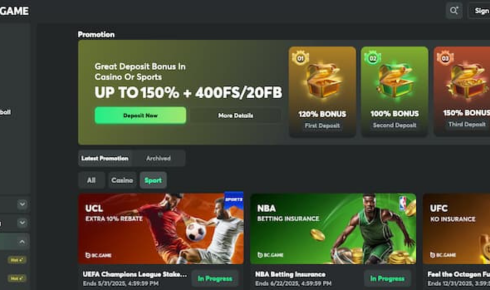West Virginia doesn’t just allow sports betting—it embraces it. From NFL Sundays to March hoops, Mountaineers have a full slate of ways to wager, whether you prefer quick picks on your phone or long-term futures you’ll track all season. This guide is your practical, no-fluff playbook for WV online sports betting—how to choose a book, build a bankroll plan, and make sharper picks without turning your hobby into homework.
Ready to compare sites? Start with our curated hub for wv online sports betting.
1) Start With “Fit,” Not FOMO
Every sportsbook markets something shiny. Ignore the hype and match the platform to your personality:
- The Minimalist: You want clean menus, fast slips, and the core markets (spreads, totals, moneylines).
- The Tinkerer: You live in props, alt lines, and same-game parlays. Tools like prop builders and odds ladders matter.
- The Live-Leaner: You plan to bet while you watch. Prioritize speed, low latency, and stable live markets.
- The Bonus Hunter: You’ll extract value from welcome offers, reloads, and insurance promos by meeting rollover terms.
Shortlist two or three books that fit your style, then keep them both. Line shopping is the single easiest edge in WV—2–5 cents of price improvement adds up fast.
2) A 10-Minute Bankroll Plan (That You’ll Actually Use)
Skip spreadsheets. Use this three-tier approach:
- Core Bankroll: The amount you can tie up for a season without stress. Keep 90% here.
- Action Wallet: 8–9% for weekly wagering. Refill from the core only once per week to prevent “tilt top-ups.”
- Fun Flyer: 1–2% reserved for longshots, parlays, or novelty markets. When it’s gone, it’s gone.
Set a unit size at 1–2% of your core bankroll. Most bets should be 1 unit; 2–3 units are for your highest-confidence plays only. Write this down—future-you will thank present-you during losing streaks.
3) Build a “WV Card” Around Your Calendar
You don’t need to bet everything. Create a weekly rhythm and stick to it:
- Mon–Tue: Futures & look-ahead lines (before the market sharpens).
- Wed–Thu: Props and derivatives (team totals, first halves/periods).
- Fri: College slates; reassess injuries and travel.
- Sat–Sun: Selective live betting—only when you’re actually watching.
This structure reduces “scroll betting” and focuses you on markets where timing provides value.
4) Your Three “Green-Flag” Bets
When in doubt, favor markets with clearer math and fewer variables:
- Alt spreads/totals with small moves where price still beats market consensus.
- Player usage props aligned with role stability (snap counts, minutes, recent coaching quotes).
- Team totals when you have a strong read on one side’s pace/efficiency but not the game script.
Fade markets where randomness dominates (e.g., multi-leg SGPs with correlated volatility) unless it’s from your Fun Flyer wallet.
5) Live Betting Without Getting Burned
Live markets are where WV bettors can thrive—or spiral. Keep it disciplined:
- Create two “if-then” scripts before the game. Example: “If WVU trails by 10+ in the first half but wins turnovers, I’ll take +5.5 live up to -115.”
- Set a timer. If you haven’t placed a live bet by halftime, stop hunting.
- Never hedge emotionally. Hedge only when the math says expected value improves—not because you’re nervous.
6) Promotions: Friend, Not Food Group
Promos are great supplements. Treat them like produce, not dessert:
- Low-rollover boosts on straight wagers are worth prioritizing over giant match offers with heavy playthrough.
- Insurance promos (parlay or overtime insurance) are valuable if you already like the bet.
- Free bet tokens are best deployed on underdogs—maximize potential return on stake-free tickets.
Always read the fine print: qualifying odds, markets excluded, and payout type (cash vs. bonus credits).
7) A WV Bettor’s Quick Data Kit
You don’t need a modeling PhD. Use a simple, repeatable checklist:
- Form & Fatigue: Days rest, travel miles, back-to-backs.
- Injuries & Rotations: Who’s out, who’s on minutes limits, who’s starting.
- Matchup Edges: Pace, rebounding, line play, special teams—one or two edges per pick.
- Price Check: Compare at least two books before locking.
If your pick doesn’t survive the checklist, pass. The best bet is often the one you don’t place.
8) Responsible Betting That Actually Works
- 80/20 Rule: 80% of your volume should be straights and small-edge props; 20% can be parlays/futures/fun.
- Two Cool-Offs: One day per week with zero bets; one week per season with no deposits.
- Loss Limit: A hard weekly cap (e.g., 5 units). If you hit it, you’re out until Monday.
Winning bettors don’t avoid losing days—they budget for them.
9) Five Mistakes WV Bettors Can Stop Making Today
- Chasing steam after a line has moved past key numbers.
- Ignoring alt lines when a small shift can dramatically improve expected value.
- Betting “because it’s on TV.” Your card should lead your screen time, not vice versa.
- Forgetting season context—motivation, standings, and tiebreakers drive late-season edges.
- Treating every promo like free money. Some are great; some are traps with rollover handcuffs.
10) Your Next Step
Dial in two books that fit your style, set a unit, write two live-bet scripts, and pick three weekly windows to bet. That’s your foundation. When you’re ready to compare operators, offers, and market depth all in one place, explore our continuously updated WV hub here: wv online sports betting.
Quick FAQ
Is WV online sports betting available statewide?
Yes—mobile and desktop options are available when you’re inside state lines.
Do I need multiple sportsbooks?
You don’t need them, but line shopping is a long-term edge. Keep at least two.
Best markets for beginners?
Straight bets (spread/total/moneyline) and simple player props linked to stable roles.
How big should my first deposit be?
Whatever lets you size one unit at 1–2% of your core bankroll without stress.

